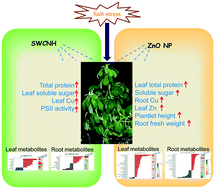Comparative physiological and metabolomics analysis reveals that single-walled carbon nanohorns and ZnO nanoparticles affect salt tolerance in Sophora alopecuroides†
Abstract
Salt stress, which is one of the limiting factors for crop yield and quality, has received more attention with increasing salinization worldwide. Here, we showed that changes in metabolomic profiling by single-walled carbon nanohorns (SWCNHs) and ZnO nanoparticles (ZnO NPs) contributed to salt tolerance in Sophora alopecuroides seedlings. Compared with untreated control plants, foliar spraying with SWCNHs increased the root length, root fresh weight and leaf soluble sugar content, while ZnO NPs increased the root fresh weight, leaf dry weight and soluble sugar content, indicating that the two engineered nanomaterials (ENMs) improved the growth of S. alopecuroides seedlings. Under salt stress, foliar spraying with SWCNHs increased the PSII activity, total protein contents of leaves and roots, leaf soluble sugar content and copper (Cu) content in the leaves, while ZnO NPs increased the plantlet height, root fresh weight, leaf total protein content, soluble sugar contents of leaves and roots, leaf zinc (Zn) content and root Cu content, thereby improving the salt tolerance of S. alopecuroides seedlings. Metabolome analysis further supported the notion that the two ENMs contributed to salt tolerance by reprogramming the carbon/nitrogen metabolism and promoting glycolysis and the TCA cycle to generate energy and increasing the levels of unsaturated fatty acids to maintain membrane integrity under salt stress. Furthermore, we revealed that, although both SWCNHs and ZnO NPs improved salt tolerance in S. alopecuroides seedlings, there were both similar and distinct mechanisms for the two ENMs in modulating plant growth and stress response. Under salt stress, the accumulation of metabolites in the leaves and roots of ZnO NP-treated plants was 4.83 fold and 3.7 fold higher than those in SWCNH-treated plants, respectively, suggesting a better effect of ZnO NPs in modulating the salt tolerance in S. alopecuroides seedlings than SWCNHs. Taken together, these results suggested that the application of the two ENMs provided a novel way to improve salt tolerance in plants.

- This article is part of the themed collection: Best Papers 2020 – Environmental Science: Nano


 Please wait while we load your content...
Please wait while we load your content...